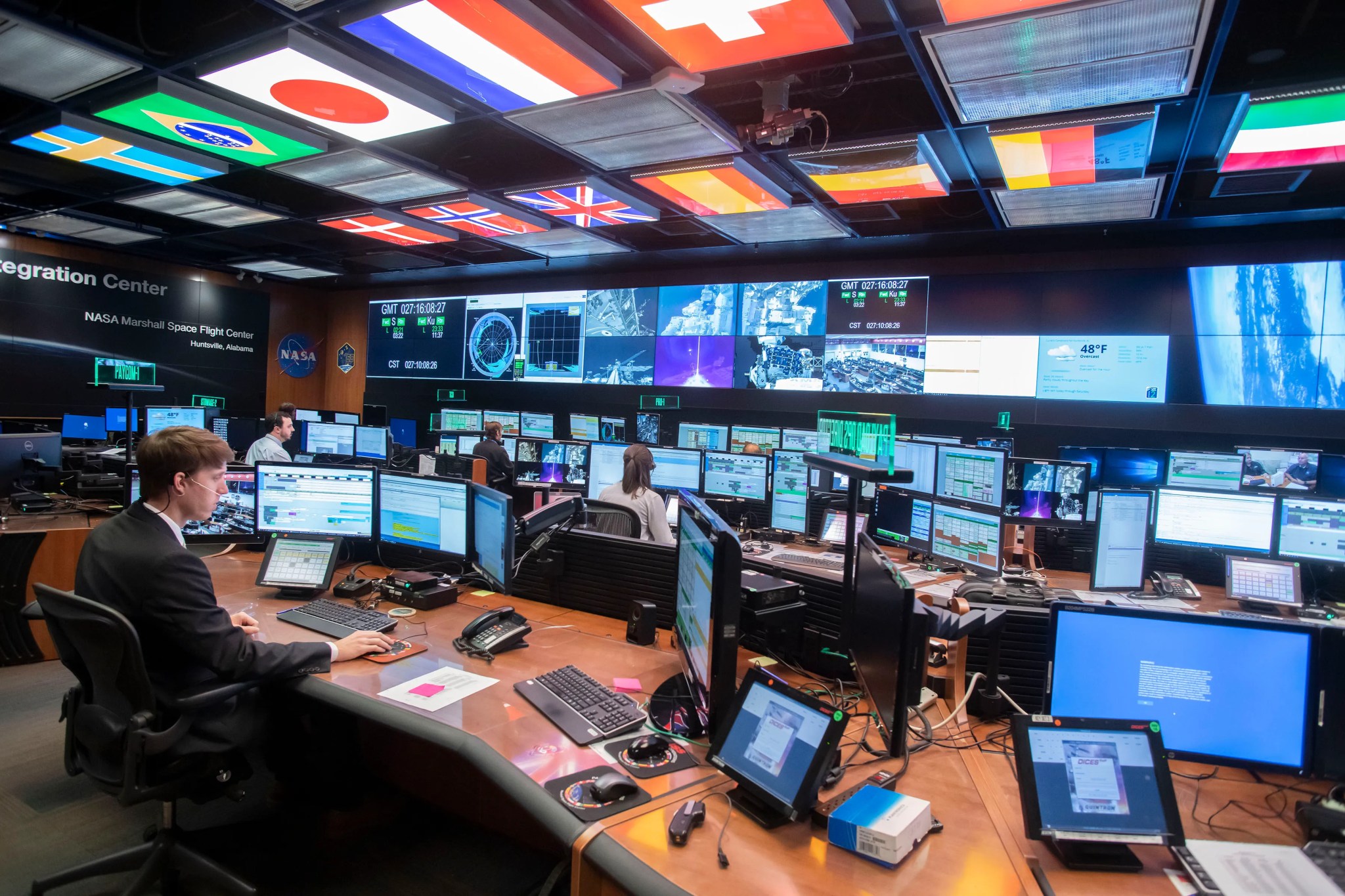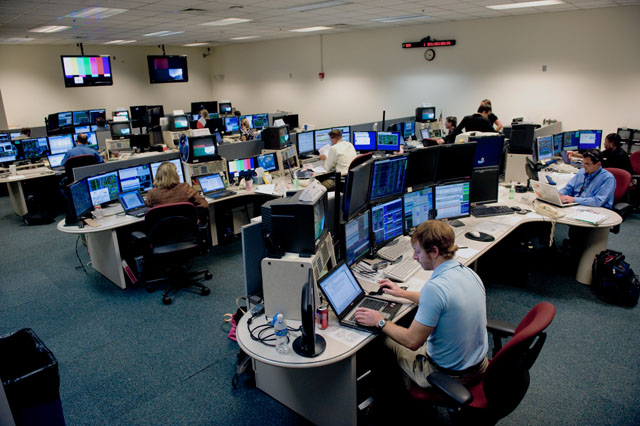It’s been a year since the Payload Operations Integration Center (POIC) at NASA’s Marshall Space Flight Center received a substantial upgrade. Many employees and visitors are amazed at the renovated room that overflows with modern technology to more effectively manage even more science than ever before aboard the International Space Station.
Walk into the room and you’ll be greeted by a large, high-resolution video wall with 24, 55-inch screens that expands the ability to share information with the POIC ground controllers, such as live video, diagrams and photographs of studies being conducted on the space station. The wall instantly enables teams to view multiple data and video feeds related to one or more experiments. With more than 200 investigations operating aboard the station at any time, it is important to share information rapidly among the ground team members so they can relay information more efficiently back to the crew in space.
“The Marshall Center has a rich history in payload and mission operations at NASA,” said Lewis Wooten, acting director for the Mission Operations Laboratory in Marshall’s Engineering Directorate. “One of the things that we are very passionate about is the enablement of scientific research.”
Wooten explained that over time, the mission operations team has significantly enhanced their technical expertise, made innovative advancements in our ground systems hardware, software and processes, and made prudent investments in facilities and infrastructure.
“All this has resulted in a cutting-edge capability for supporting operations critical to a variety of space missions,” he said.
Since 2001, the operations center has worked with thousands of scientific investigators from around the world to perform scientific research in a variety of disciplines from astrophysics to human research to technology demonstrations to help future space explorers.
But the POIC isn’t the only advanced facility behind the walls of Building 4663, also known as the Huntsville Operations Support Center (HOSC). You’ll also find the “air traffic controller” of the operations center, the Data Operations Control Room, filled with a dedicated team whose primary purpose is to provide ground support. Here, a group of employees take in science data from the space station, and distribute it to the POIC and those who have experiments on the orbiting laboratory.
Also joining these command centers is the Marshall Backup Control Center to Mission Control Center at NASA’s Johnson Space Center in Houston, with capabilities to allow the flight control team to perform the same functions for the station as if they were in Houston. It became operational Aug. 7, 2008, and just a month later the backup room was put to work as powerful and destructive Hurricane Ike made landfall in Texas. This triggered evacuations and the team made its way from Johnson to Backup Control Center adjacent to the POIC — temporarily becoming the prime location for space station operations.
With the full activation of the system, Johnson’s station flight controllers operated alongside Marshall’s payload flight controllers for almost five days, executing critical operations, including the docking of a Russian Progress resupply vehicle on Sept. 16, 2008. Since then, teams have worked together to train and certify the Backup Control Center operational systems for each hurricane season.
“Certification for the 2014 hurricane season was completed May 27,” said Angela Marsh, chief of the Mission Operations Systems Branch in the Engineering Directorate. Over the last three months, Marshall and Johnson upgraded systems and executed operations to test the support system. Each year during certification, Houston gives full systems control to Marshall to ensure operational connectivity. “During an emergency, it is important to have confidence that the Backup Control Center will be operational and ready to support station operations without skipping a beat,” Marsh said.
Recent discussions have resulted in an agreement for Space Exploration Technologies Corp. (SpaceX) to place a rack of hardware at the HOSC to be activated should Johnson go offline. SpaceX is commercial spacecraft company headquartered in Hawthorne, California.
“We have been asked to support SpaceX by providing a data point to route Dragon spacecraft data to its backup center in Cape Canaveral, Florida, if SpaceX’s headquarters suffers a disastrous event such as an earthquake,” said Marsh. “They’ve requested to use the new HOSC interface and communications systems during potential outages.”
Building 4663 also houses the Laboratory Training Complex and simulation rooms used to prepare for station expeditions, and has the resources for the creation of mission operations laboratory control rooms if needed. Most recently, space was made to support a two-year mission — Fast, Affordable, Science and Technology SATellite — successfully demonstrating a capability to build, deploy and operate a science and technology flight mission at lower costs than previously possible.
The Laboratory Training Complex provides a hands-on training environment for ground members at Marshall to support science operations for U.S. payloads aboard the station.
Physical mock-ups and glass rack models replicate station facilities, and functionally or physically simulate flight and ground interfaces. Inside the complex, flight controllers practice station experiment operations before missions. During a mission, controllers can use the training complex as an aid for resolving issues encountered while station astronauts perform experiments in space.
The complex provides opportunities for the ground team members to train and familiarize themselves with flight facilities and experiments, including numerous new experiments that are added for each station expedition.
To learn more about payload operations capabilities at the center, catch this Space Station Live interview with Marsh as she takes us behind the scenes in Building 4663.




























